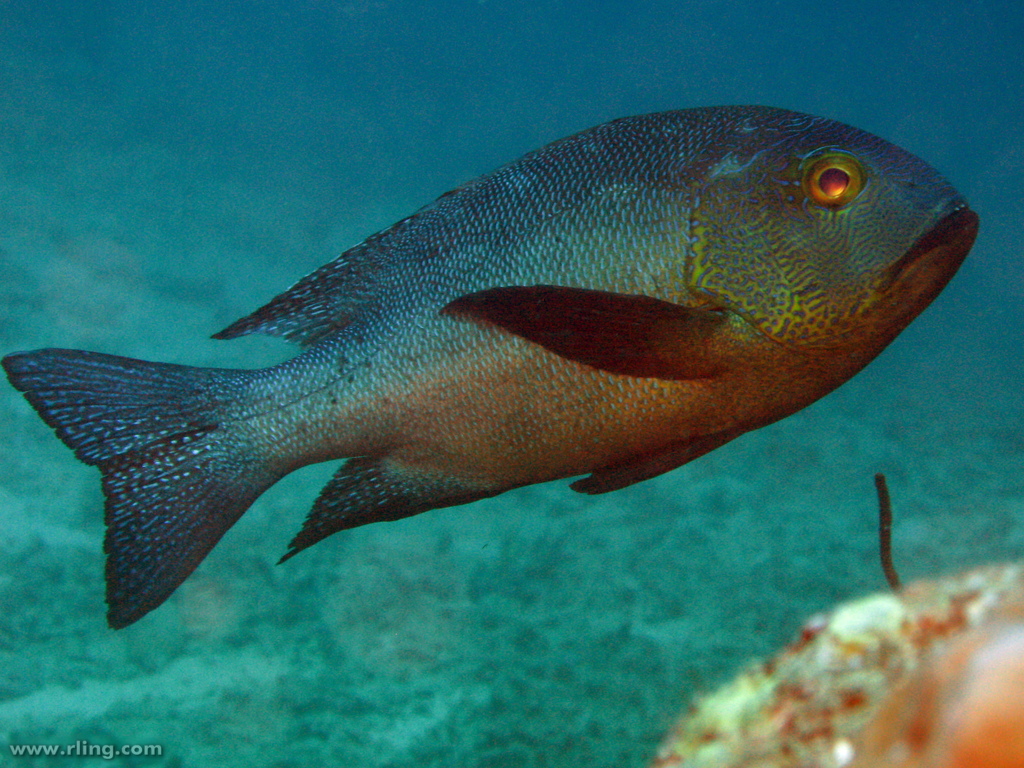- Classification
- ACTINOPTERYGII
- PERCIFORMES
- LUTJANIDAE
- Macolor
- macularis
Midnight Snapper, Macolor macularis Fowler 1931
Other Names: Midnight Seaperch

A Midnight Snapper, Macolor macularis, at The Bistro, Beqa Lagoon, Fiji. Source: Richard Ling / Flickr. License: CC by Attribution-NonCommercial-ShareAlike
Cite this page as:
Bray, D.J. 2020, Macolor macularis in Fishes of Australia, accessed 24 Apr 2024, https://fishesofaustralia.net.au/home/species/1244
Midnight Snapper, Macolor macularis Fowler 1931
More Info
|
Distribution |
Offshore reefs of north Western Australia, Ashmore Reef in the Timor Sea, the Arafura Sea, Northern Territory, and the Great Barrier Reef, Queensland, and reefs in the Coral Sea; also Christmas Island in the eastern Indian Ocean. Elsewhere the species occurs in the tropical, east-Indo-west Pacific. Inhabits steep slopes of lagoon, channel, or seaward reefsJuveniles occur singly on protected reef slopes with feather stars, or inside staghorn corals or large sponges. Adults commonly occur on deep reef slopes and may be in small groups |
|
Feeding |
Feeds mostly at night on large zooplankton, along with fish and crustaceans. |
|
Biology |
A long-lived species. On the Great Barrier Reef, Queensland, the species is thought to reach ages of 40-50 years. One individual from Rowley Shoals, Western Australia, was found to be 81 years (Taylor et al. 2020) |
|
Similar Species |
The Midnight Snapper differs from the Black-and-white Snapper, Macolor niger,in having 10 soft rays in the anal fin (vs 11 in M. niger), 110-122 gill rakers (vs 89-107), a small part of the maxillary bone exposed, (vs a long triangular area exposed in M. niger), juveniles with long pointed pelvic fins (vs not elongate at any size in M. niger), and adults have blue spots on the head and fins (vs colour almost uniformly black in M. niger). |
|
Etymology |
The specific name macularis is from the Latin macula (= a spot, stain), presumably in reference to the pale spots on the scales: 'Each scale on back with pale gray white basal spot.' and 'most every scale with pale spot, often forming vermiculations'. |
|
Species Citation |
Macolor macularis Fowler 1931, Bulletin of the United States National Museum 100(11): 181. Type locality: Philippines. |
|
Author |
Bray, D.J. 2020 |
|
Resources |
Midnight Snapper, Macolor macularis Fowler 1931
References
Allen, G.R. 1985. FAO Species Catalogue. Snappers of the World. An annotated and illustrated catalogue of lutjanid species known to date. FAO Fisheries Synopsis No. 125, Vol. 6. Rome : FAO 208 pp.
Allen, G.R. 1997. Marine Fishes of Tropical Australia and South-east Asia. Perth : Western Australian Museum 292 pp. 106 pls.
Allen, G.R. & Erdmann, M.V. 2012. Reef fishes of the East Indies. Perth : Tropical Reef Research 3 vols, 1260 pp.
Allen, G.R., Steene, R.C. & Orchard, M. 2007. Fishes of Christmas Island. Christmas Island : Christmas Island Natural History Association 2 edn, 284 pp.
Anderson, W.D. & Allen, G.R. 2001. Lutjanidae. pp. 2840-2918 in Carpenter, K.E. & Niem, V.H. (eds). The Living Marine Resources of the Western Central Pacific. FAO Species Identification Guide for Fisheries Purposes. Rome : FAO Vol. 5 2791-3379 pp.
Fowler, H.W. 1931. Contributions to the biology of the Philippine Archipelago and adjacent regions. The fishes of the families Pseudochromidae, Lobotidae, Pempheridae, Priacanthidae, Lutjanidae, Pomadasyidae, and Terapontidae collected by the United States Bureau of Fisheries Steamer Albatross, chiefly in Philippine seas and adjacent waters. Bulletin of the United States National Museum 100(11): 1-388 figs 1-29 See ref at BHL
Hay, A.C. & Leis, J.M. 2011. The pelagic larva of the midnight snapper, Macolor macularis (Teleostei: Lutjanidae). Records of the Australian Museum 63: 85-88. https://doi.org/10.3853/j.0067-1975.63.2011.1578
Hutchins, J.B., Williams, D.McB., Newman, S.J., Cappo, M. & Speare, P. 1995. New records of fishes for the Rowley Shoals and Scott/Seringapatam Reefs, off north-western Australia. Records of the Western Australian Museum 17: 119-123
Kishimoto, H., Amaoka, K., Kohno, H. & Hamaguchi, T. 1987. A revision of the black-and-white snappers, genus Macolor (Perciformes: Lutjanidae). Japanese Journal of Ichthyology 34(2): 146-156. https://doi.org/10.11369/jji1950.34.146
Kuiter, R.H. 1992. Tropical Reef-Fishes of the Western Pacific, Indonesia and Adjacent Waters. Jakarta : PT Gramedia Pustaka Utama 314 pp. pls.
Kuiter, R.H. 1996. Guide to Sea Fishes of Australia. A comprehensive reference for divers and fishermen. Sydney, NSW, Australia : New Holland Publishers xvii, 434 pp.
Larson, H.K., Williams, R.S. & Hammer, M.P. 2013. An annotated checklist of the fishes of the Northern Territory, Australia. Zootaxa 3696(1): 1-293
Leis, J.M. 2007. Larval development in the lutjanid subfamily Lutjaninae (Pisces): the genus Macolor. Records of the Australian Museum 59(1): 1-8 https://doi.org/10.3853/j.0067-1975.59.2007.1484
Randall, J.E., Allen, G.R. & Steene, R. 1990. Fishes of the Great Barrier Reef and Coral Sea. Bathurst : Crawford House Press 507 pp. figs.
Randall, J.E., Allen, G.R. & Steene, R. 1997. Fishes of the Great Barrier Reef and Coral Sea. Bathurst : Crawford House Press 557 pp. figs.
Russell, B.C., Larson, H.K., Hutchins, J.B. & Allen, G.R. 2005. Reef fishes of the Sahul Shelf. The Beagle, Records of the Museums and Art Galleries of the Northern Territory Supplement 1 2005: 83-105
Russell, B., Smith-Vaniz, W.F., Lawrence, A., Carpenter, K.E. & Myers, R. 2016. Macolor macularis. The IUCN Red List of Threatened Species 2016: e.T194348A2318123. https://dx.doi.org/10.2305/IUCN.UK.2016-3.RLTS.T194348A2318123.en. Downloaded on 11 December 2020.
Taylor, B.M., Wakefield, C.B., Newman, S.J. et al. 2020. Unprecedented longevity of unharvested shallow-water snappers in the Indian Ocean. Coral Reefs. https://doi.org/10.1007/s00338-020-02032-3










